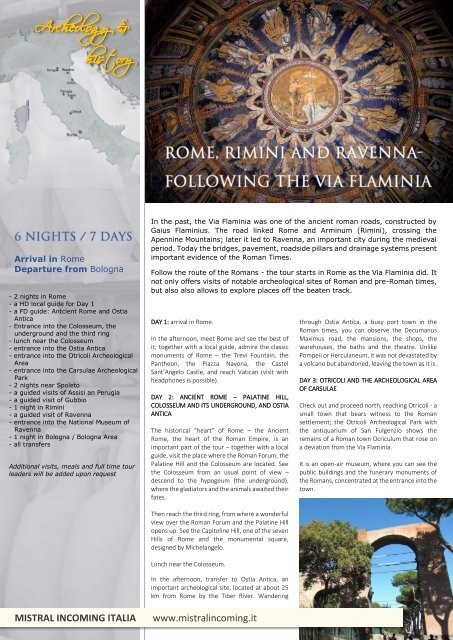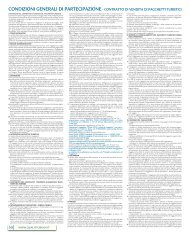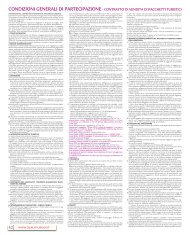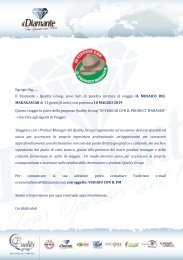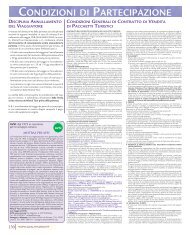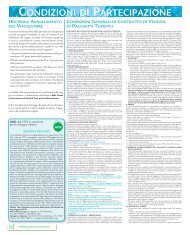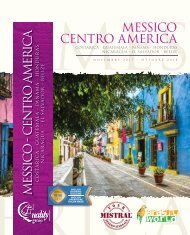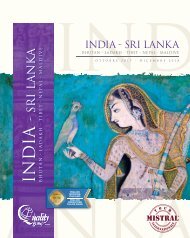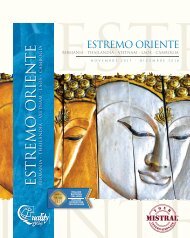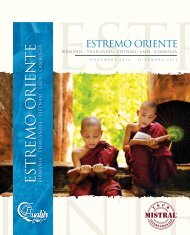You also want an ePaper? Increase the reach of your titles
YUMPU automatically turns print PDFs into web optimized ePapers that Google loves.
Arrival in <strong>Rome</strong><br />
Departure from Bologna<br />
- 2 nights in <strong>Rome</strong><br />
- a HD local guide for Day 1<br />
- a FD guide: Antcient <strong>Rome</strong> <strong>and</strong> Ostia<br />
Antica<br />
- Entrance into the Colosseum, the<br />
underground <strong>and</strong> the third ring<br />
- lunch near the Colosseum<br />
- entrance into the Ostia Antica<br />
- entrance into the Otricoli Archeological<br />
Area<br />
- entrance into the Carsulae Archeological<br />
Park<br />
- 2 nights near Spoleto<br />
- a guided visits of Assisi an Perugia<br />
- a guided visit of Gubbio<br />
- 1 night in <strong>Rimini</strong><br />
- a guided visit of <strong>Ravenna</strong><br />
- entrance into the National Museum of<br />
<strong>Ravenna</strong><br />
- 1 night in Bologna / Bologna Area<br />
- all transfers<br />
Additional visits, meals <strong>and</strong> full time tour<br />
leaders will be added upon request<br />
In the past, the Via Flaminia was one of the ancient roman roads, constructed by<br />
Gaius Flaminius. The road linked <strong>Rome</strong> <strong>and</strong> Arminum (<strong>Rimini</strong>), crossing the<br />
Apennine Mountains; later it led to <strong>Ravenna</strong>, an important city during the medieval<br />
period. Today the bridges, pavement, roadside pillars <strong>and</strong> drainage systems present<br />
important evidence of the Roman Times.<br />
Follow the route of the Romans - the tour starts in <strong>Rome</strong> as the Via Flaminia did. It<br />
not only offers visits of notable archeological sites of Roman <strong>and</strong> pre-Roman times,<br />
but also also allows to explore places off the beaten track.<br />
DAY 1: arrival in <strong>Rome</strong>.<br />
In the afternoon, meet <strong>Rome</strong> <strong>and</strong> see the best of<br />
it; together with a local guide, admire the classic<br />
monuments of <strong>Rome</strong> – the Trevi Fountain, the<br />
Pantheon, the Piazza Navona, the Castel<br />
Sant’Angelo Castle, <strong>and</strong> reach Vatican (visit with<br />
headphones is possible).<br />
DAY 2: ANCIENT ROME – PALATINE HILL,<br />
COLOSSEUM AND ITS UNDERGROUND, AND OSTIA<br />
ANTICA<br />
The historical “heart” of <strong>Rome</strong> – the Ancient<br />
<strong>Rome</strong>, the heart of the Roman Empire, is an<br />
important part of the tour – together with a local<br />
guide, visit the place where the Roman Forum, the<br />
Palatine Hill <strong>and</strong> the Colosseum are located. See<br />
the Colosseum from an usual point of view –<br />
descend to the hypogeum (the underground),<br />
where the gladiators <strong>and</strong> the animals awaited their<br />
fates.<br />
through Ostia Antica, a busy port town in the<br />
Roman times, you can observe the Decumanus<br />
Maximus road, the mansions, the shops, the<br />
warehouses, the baths <strong>and</strong> the theatre. Unlike<br />
Pompeii or Herculaneum, it was not devastated by<br />
a volcano but ab<strong>and</strong>oned, leaving the town as it is.<br />
DAY 3: OTRICOLI AND THE ARCHEOLOGICAL AREA<br />
OF CARSULAE<br />
Check out <strong>and</strong> proceed north, reaching Otricoli - a<br />
small town that bears witness to the Roman<br />
settlement; the Otricoli Archeological Park with<br />
the antiquarium of San Fulgenzio shows the<br />
remains of a Roman town Ocriculum that rose on<br />
a deviation from the Via Flaminia.<br />
It is an open-air museum, where you can see the<br />
public buildings <strong>and</strong> the funerary monuments of<br />
the Romans, concentrated at the entrance into the<br />
town.<br />
Then reach the third ring, from where a wonderful<br />
view over the Roman Forum <strong>and</strong> the Palatine Hill<br />
opens up. See the Capitoline Hill, one of the seven<br />
Hills of <strong>Rome</strong> <strong>and</strong> the monumental square,<br />
designed by Michelangelo.<br />
Lunch near the Colosseum.<br />
In the afternoon, transfer to Ostia Antica, an<br />
important archeological site, located at about 25<br />
km from <strong>Rome</strong> by the Tiber River. W<strong>and</strong>ering<br />
MISTRAL INCOMING ITALIA<br />
www.mistralincoming.it
The next stop – the Carsulae archeological excavations. Carsulae, an<br />
ancient Roman town, lies in a suggestive area, between the medieval<br />
San Gemini <strong>and</strong> Terre Arnolfe.<br />
At the end of the day, you might wish to see the spectacular Marmore<br />
Falls, located nearby (on Unesco list).<br />
DAY 4: ASSISI AND PERUGIA<br />
On today’s programme there are two well-known destinations, Assisi<br />
<strong>and</strong> Perugia.<br />
The virtually untouched medieval town Assisi is perched on the slope of<br />
the Mount Subasio, <strong>and</strong> is also known as the birthplace of Saint Francis.<br />
The visit of this town starts with a stroll through its centre, on its<br />
cobblestone streets – Assisi is a comparatively small pearl <strong>and</strong> can be<br />
easily explored on foot. Admire the Temple of Minerva, a building of<br />
Roman origins. You should certainly visit the Basilica of San Francesco<br />
(Saint Francis) – a spiritually powerful place. Start at the upper Basilica.<br />
Then reach the lower church <strong>and</strong> descend the stairs to the Tomb of<br />
Saint Francis.<br />
Perugia, a large hill town that lives an intense life, is closely linked to<br />
the presence of an important university attracting numerous foreign<br />
students. The town offers also a sheer variety of narrow cobblestone<br />
streets to w<strong>and</strong>er along while enjoying its medieval character. Perugia<br />
is also known for chocolato – the chocolate <strong>and</strong> its architecture.<br />
DAY 5: GUBBIO, FANO AND RIMINI<br />
Check out <strong>and</strong> reach Gubbio, which lies on the slopes of Mt. Ingino <strong>and</strong><br />
has very old origins. It was also an important city during Roman times<br />
(you can admire the Roman Theatre built of limestone, dating back<br />
from the 1 st century AD).<br />
Fano was a Roman colony, Fanum Fortunae (named in honour of the<br />
goddess of Fortune). In Roman times it was a crossroads between Via<br />
Flaminia <strong>and</strong> the coastal route. Today it is a pretty seaside town, but<br />
you can still admire the Arch of Augustus – the entrance to the town.<br />
Overnight stay in <strong>Rimini</strong>, a popular seaside resort.<br />
DAY 6: RAVENNA<br />
<strong>Ravenna</strong> is the city of Byzantine mosaics; eight of its historic buildings<br />
st<strong>and</strong> on the World Heritage List. It is full of treasures – the Basilica San<br />
Vitale, the Mausoleum of Galla Placida, <strong>and</strong> the Piazza del Popolo<br />
definitely st<strong>and</strong> out. Visit the National Museum of <strong>Ravenna</strong>, which<br />
contains a vast collection of artifacts from the Greek <strong>and</strong> Byzantine<br />
times.<br />
Reach your hotel in Bologna/ Bologna area.<br />
DAY 7: check out <strong>and</strong> departure<br />
MISTRAL INCOMING ITALIA<br />
www.mistralincoming.it


